UNIT 24 Assignment: Understanding Learning in Health & Social Care
VerifiedAdded on 2024/05/14
|28
|5027
|379
Essay
AI Summary
This assignment delves into understanding the learning process within health and social care contexts. It begins by explaining Bloom's Taxonomy of Learning Domains and its relevance to health and social care, followed by an exploration of different learning methods in these workplaces. A case study analyzes how learning theories relate to skill development and understanding in this sector. The assignment further discusses factors influencing effective learning, concepts of learning styles, and a personal assessment using the VARK system. It also analyzes influences affecting personal learning in relation to learning theories. Furthermore, it describes factors to consider in a workplace learning plan, presents teaching strategies to support learning, and suggests a strategy for delivering and assessing learning. Finally, it addresses barriers to learning for staff and service users and methods to identify their learning needs, concluding with supporting individual learning needs and evaluating the approaches used. Desklib provides a platform for students to access this and similar solved assignments.
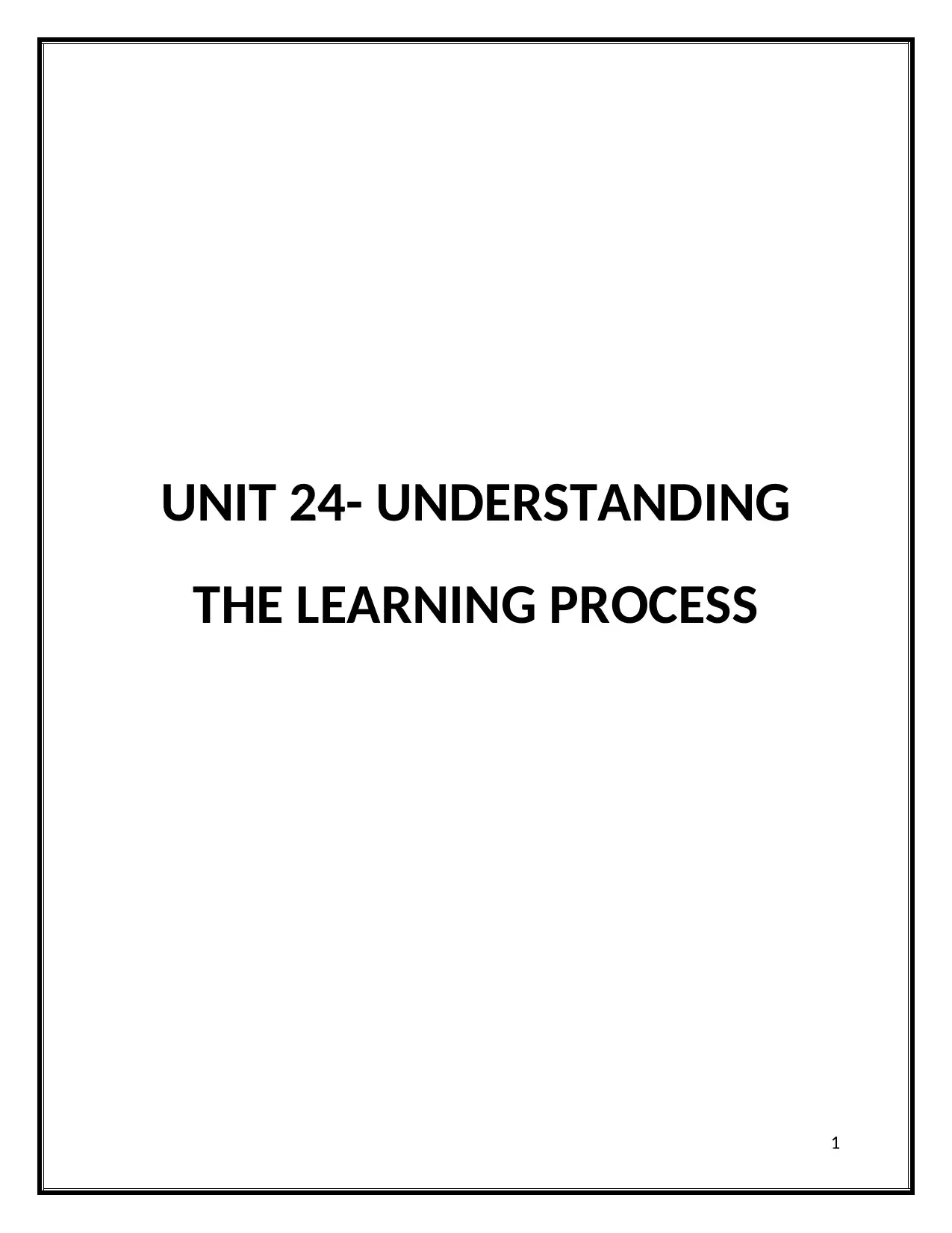
UNIT 24- UNDERSTANDING
THE LEARNING PROCESS
1
THE LEARNING PROCESS
1
Paraphrase This Document
Need a fresh take? Get an instant paraphrase of this document with our AI Paraphraser
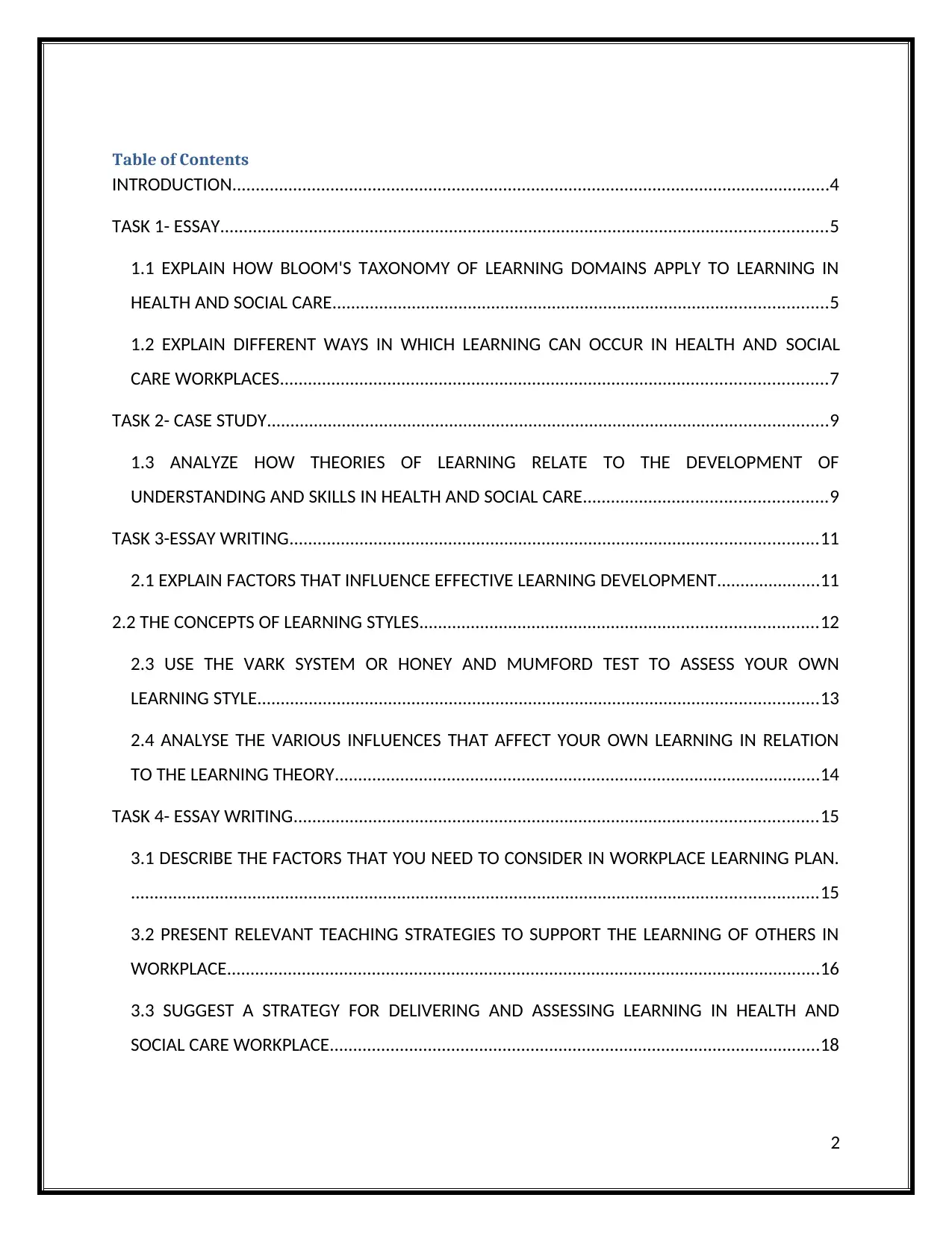
Table of Contents
INTRODUCTION................................................................................................................................4
TASK 1- ESSAY..................................................................................................................................5
1.1 EXPLAIN HOW BLOOM'S TAXONOMY OF LEARNING DOMAINS APPLY TO LEARNING IN
HEALTH AND SOCIAL CARE..........................................................................................................5
1.2 EXPLAIN DIFFERENT WAYS IN WHICH LEARNING CAN OCCUR IN HEALTH AND SOCIAL
CARE WORKPLACES.....................................................................................................................7
TASK 2- CASE STUDY........................................................................................................................9
1.3 ANALYZE HOW THEORIES OF LEARNING RELATE TO THE DEVELOPMENT OF
UNDERSTANDING AND SKILLS IN HEALTH AND SOCIAL CARE....................................................9
TASK 3-ESSAY WRITING.................................................................................................................11
2.1 EXPLAIN FACTORS THAT INFLUENCE EFFECTIVE LEARNING DEVELOPMENT......................11
2.2 THE CONCEPTS OF LEARNING STYLES.....................................................................................12
2.3 USE THE VARK SYSTEM OR HONEY AND MUMFORD TEST TO ASSESS YOUR OWN
LEARNING STYLE........................................................................................................................13
2.4 ANALYSE THE VARIOUS INFLUENCES THAT AFFECT YOUR OWN LEARNING IN RELATION
TO THE LEARNING THEORY........................................................................................................14
TASK 4- ESSAY WRITING................................................................................................................15
3.1 DESCRIBE THE FACTORS THAT YOU NEED TO CONSIDER IN WORKPLACE LEARNING PLAN.
...................................................................................................................................................15
3.2 PRESENT RELEVANT TEACHING STRATEGIES TO SUPPORT THE LEARNING OF OTHERS IN
WORKPLACE...............................................................................................................................16
3.3 SUGGEST A STRATEGY FOR DELIVERING AND ASSESSING LEARNING IN HEALTH AND
SOCIAL CARE WORKPLACE.........................................................................................................18
2
INTRODUCTION................................................................................................................................4
TASK 1- ESSAY..................................................................................................................................5
1.1 EXPLAIN HOW BLOOM'S TAXONOMY OF LEARNING DOMAINS APPLY TO LEARNING IN
HEALTH AND SOCIAL CARE..........................................................................................................5
1.2 EXPLAIN DIFFERENT WAYS IN WHICH LEARNING CAN OCCUR IN HEALTH AND SOCIAL
CARE WORKPLACES.....................................................................................................................7
TASK 2- CASE STUDY........................................................................................................................9
1.3 ANALYZE HOW THEORIES OF LEARNING RELATE TO THE DEVELOPMENT OF
UNDERSTANDING AND SKILLS IN HEALTH AND SOCIAL CARE....................................................9
TASK 3-ESSAY WRITING.................................................................................................................11
2.1 EXPLAIN FACTORS THAT INFLUENCE EFFECTIVE LEARNING DEVELOPMENT......................11
2.2 THE CONCEPTS OF LEARNING STYLES.....................................................................................12
2.3 USE THE VARK SYSTEM OR HONEY AND MUMFORD TEST TO ASSESS YOUR OWN
LEARNING STYLE........................................................................................................................13
2.4 ANALYSE THE VARIOUS INFLUENCES THAT AFFECT YOUR OWN LEARNING IN RELATION
TO THE LEARNING THEORY........................................................................................................14
TASK 4- ESSAY WRITING................................................................................................................15
3.1 DESCRIBE THE FACTORS THAT YOU NEED TO CONSIDER IN WORKPLACE LEARNING PLAN.
...................................................................................................................................................15
3.2 PRESENT RELEVANT TEACHING STRATEGIES TO SUPPORT THE LEARNING OF OTHERS IN
WORKPLACE...............................................................................................................................16
3.3 SUGGEST A STRATEGY FOR DELIVERING AND ASSESSING LEARNING IN HEALTH AND
SOCIAL CARE WORKPLACE.........................................................................................................18
2
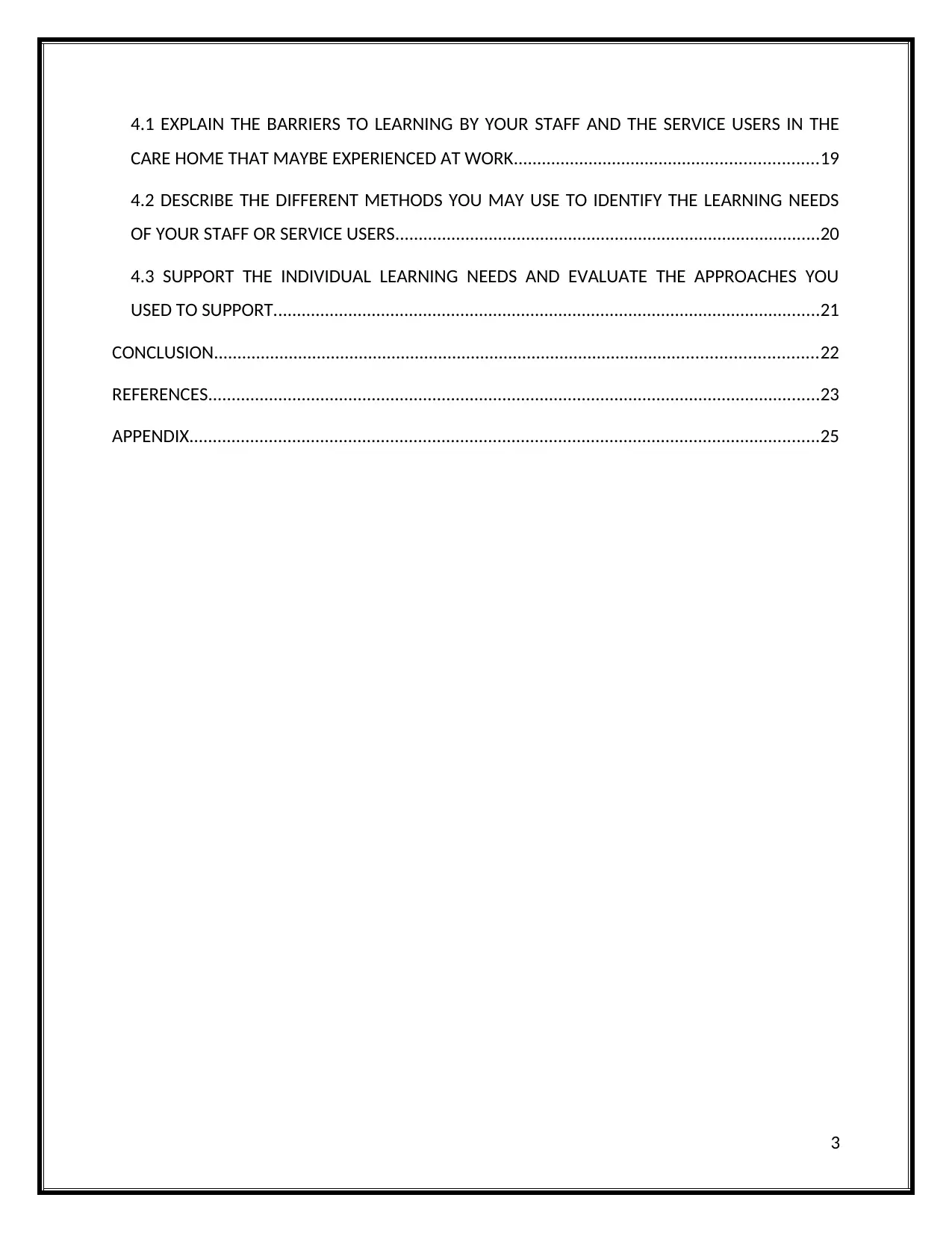
4.1 EXPLAIN THE BARRIERS TO LEARNING BY YOUR STAFF AND THE SERVICE USERS IN THE
CARE HOME THAT MAYBE EXPERIENCED AT WORK.................................................................19
4.2 DESCRIBE THE DIFFERENT METHODS YOU MAY USE TO IDENTIFY THE LEARNING NEEDS
OF YOUR STAFF OR SERVICE USERS...........................................................................................20
4.3 SUPPORT THE INDIVIDUAL LEARNING NEEDS AND EVALUATE THE APPROACHES YOU
USED TO SUPPORT.....................................................................................................................21
CONCLUSION.................................................................................................................................22
REFERENCES...................................................................................................................................23
APPENDIX.......................................................................................................................................25
3
CARE HOME THAT MAYBE EXPERIENCED AT WORK.................................................................19
4.2 DESCRIBE THE DIFFERENT METHODS YOU MAY USE TO IDENTIFY THE LEARNING NEEDS
OF YOUR STAFF OR SERVICE USERS...........................................................................................20
4.3 SUPPORT THE INDIVIDUAL LEARNING NEEDS AND EVALUATE THE APPROACHES YOU
USED TO SUPPORT.....................................................................................................................21
CONCLUSION.................................................................................................................................22
REFERENCES...................................................................................................................................23
APPENDIX.......................................................................................................................................25
3
⊘ This is a preview!⊘
Do you want full access?
Subscribe today to unlock all pages.

Trusted by 1+ million students worldwide
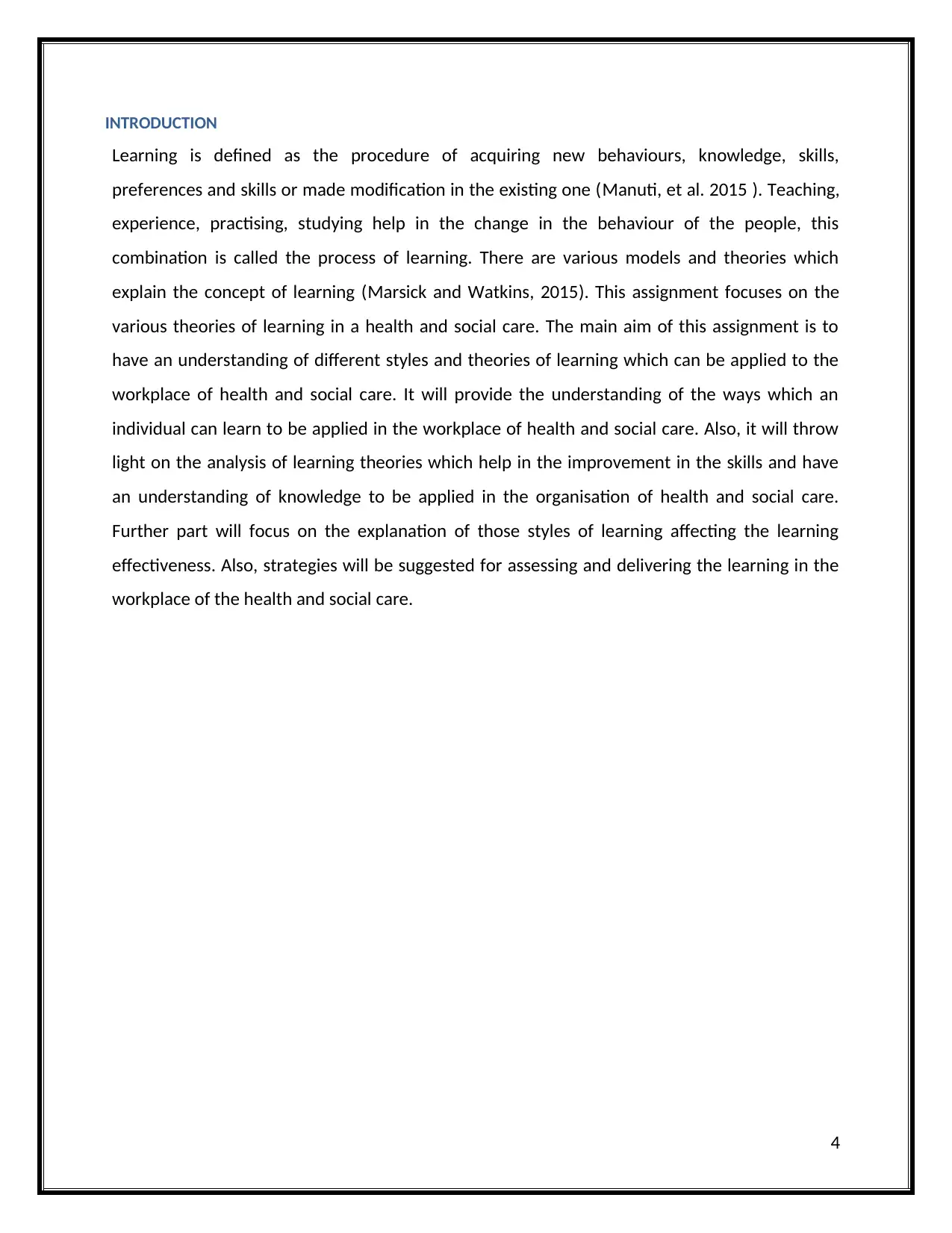
INTRODUCTION
Learning is defined as the procedure of acquiring new behaviours, knowledge, skills,
preferences and skills or made modification in the existing one (Manuti, et al. 2015 ). Teaching,
experience, practising, studying help in the change in the behaviour of the people, this
combination is called the process of learning. There are various models and theories which
explain the concept of learning (Marsick and Watkins, 2015). This assignment focuses on the
various theories of learning in a health and social care. The main aim of this assignment is to
have an understanding of different styles and theories of learning which can be applied to the
workplace of health and social care. It will provide the understanding of the ways which an
individual can learn to be applied in the workplace of health and social care. Also, it will throw
light on the analysis of learning theories which help in the improvement in the skills and have
an understanding of knowledge to be applied in the organisation of health and social care.
Further part will focus on the explanation of those styles of learning affecting the learning
effectiveness. Also, strategies will be suggested for assessing and delivering the learning in the
workplace of the health and social care.
4
Learning is defined as the procedure of acquiring new behaviours, knowledge, skills,
preferences and skills or made modification in the existing one (Manuti, et al. 2015 ). Teaching,
experience, practising, studying help in the change in the behaviour of the people, this
combination is called the process of learning. There are various models and theories which
explain the concept of learning (Marsick and Watkins, 2015). This assignment focuses on the
various theories of learning in a health and social care. The main aim of this assignment is to
have an understanding of different styles and theories of learning which can be applied to the
workplace of health and social care. It will provide the understanding of the ways which an
individual can learn to be applied in the workplace of health and social care. Also, it will throw
light on the analysis of learning theories which help in the improvement in the skills and have
an understanding of knowledge to be applied in the organisation of health and social care.
Further part will focus on the explanation of those styles of learning affecting the learning
effectiveness. Also, strategies will be suggested for assessing and delivering the learning in the
workplace of the health and social care.
4
Paraphrase This Document
Need a fresh take? Get an instant paraphrase of this document with our AI Paraphraser
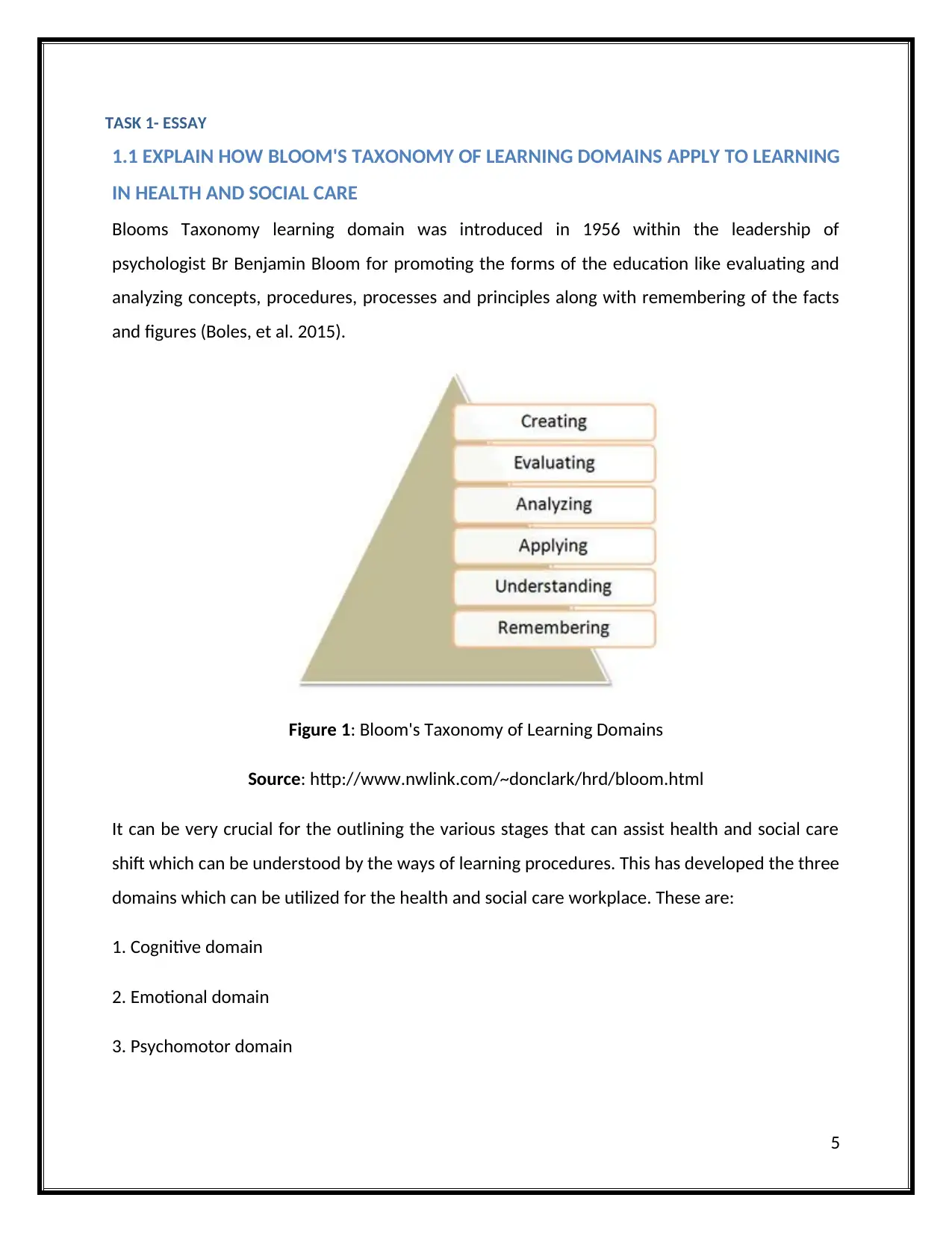
TASK 1- ESSAY
1.1 EXPLAIN HOW BLOOM'S TAXONOMY OF LEARNING DOMAINS APPLY TO LEARNING
IN HEALTH AND SOCIAL CARE
Blooms Taxonomy learning domain was introduced in 1956 within the leadership of
psychologist Br Benjamin Bloom for promoting the forms of the education like evaluating and
analyzing concepts, procedures, processes and principles along with remembering of the facts
and figures (Boles, et al. 2015).
Figure 1: Bloom's Taxonomy of Learning Domains
Source: http://www.nwlink.com/~donclark/hrd/bloom.html
It can be very crucial for the outlining the various stages that can assist health and social care
shift which can be understood by the ways of learning procedures. This has developed the three
domains which can be utilized for the health and social care workplace. These are:
1. Cognitive domain
2. Emotional domain
3. Psychomotor domain
5
1.1 EXPLAIN HOW BLOOM'S TAXONOMY OF LEARNING DOMAINS APPLY TO LEARNING
IN HEALTH AND SOCIAL CARE
Blooms Taxonomy learning domain was introduced in 1956 within the leadership of
psychologist Br Benjamin Bloom for promoting the forms of the education like evaluating and
analyzing concepts, procedures, processes and principles along with remembering of the facts
and figures (Boles, et al. 2015).
Figure 1: Bloom's Taxonomy of Learning Domains
Source: http://www.nwlink.com/~donclark/hrd/bloom.html
It can be very crucial for the outlining the various stages that can assist health and social care
shift which can be understood by the ways of learning procedures. This has developed the three
domains which can be utilized for the health and social care workplace. These are:
1. Cognitive domain
2. Emotional domain
3. Psychomotor domain
5
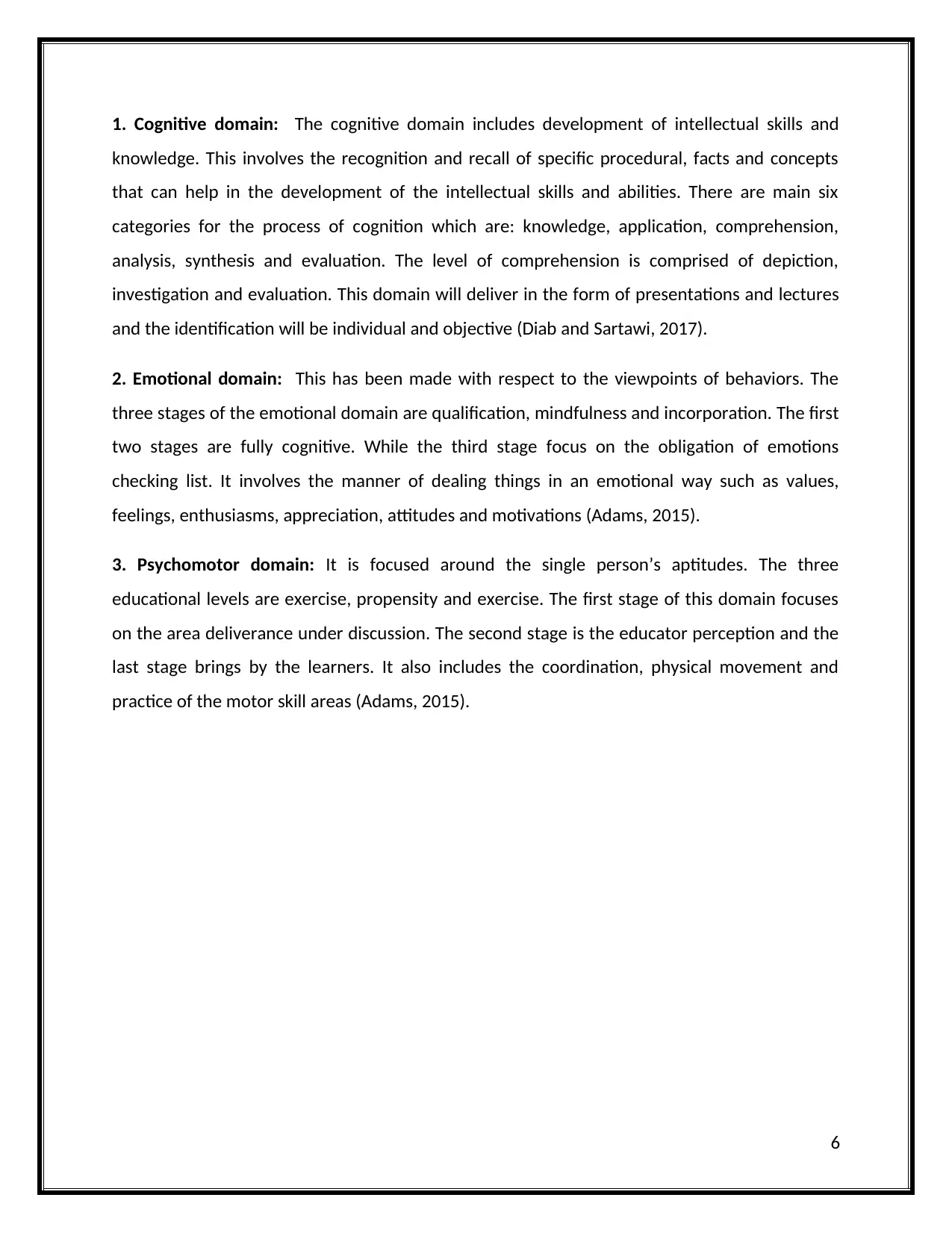
1. Cognitive domain: The cognitive domain includes development of intellectual skills and
knowledge. This involves the recognition and recall of specific procedural, facts and concepts
that can help in the development of the intellectual skills and abilities. There are main six
categories for the process of cognition which are: knowledge, application, comprehension,
analysis, synthesis and evaluation. The level of comprehension is comprised of depiction,
investigation and evaluation. This domain will deliver in the form of presentations and lectures
and the identification will be individual and objective (Diab and Sartawi, 2017).
2. Emotional domain: This has been made with respect to the viewpoints of behaviors. The
three stages of the emotional domain are qualification, mindfulness and incorporation. The first
two stages are fully cognitive. While the third stage focus on the obligation of emotions
checking list. It involves the manner of dealing things in an emotional way such as values,
feelings, enthusiasms, appreciation, attitudes and motivations (Adams, 2015).
3. Psychomotor domain: It is focused around the single person’s aptitudes. The three
educational levels are exercise, propensity and exercise. The first stage of this domain focuses
on the area deliverance under discussion. The second stage is the educator perception and the
last stage brings by the learners. It also includes the coordination, physical movement and
practice of the motor skill areas (Adams, 2015).
6
knowledge. This involves the recognition and recall of specific procedural, facts and concepts
that can help in the development of the intellectual skills and abilities. There are main six
categories for the process of cognition which are: knowledge, application, comprehension,
analysis, synthesis and evaluation. The level of comprehension is comprised of depiction,
investigation and evaluation. This domain will deliver in the form of presentations and lectures
and the identification will be individual and objective (Diab and Sartawi, 2017).
2. Emotional domain: This has been made with respect to the viewpoints of behaviors. The
three stages of the emotional domain are qualification, mindfulness and incorporation. The first
two stages are fully cognitive. While the third stage focus on the obligation of emotions
checking list. It involves the manner of dealing things in an emotional way such as values,
feelings, enthusiasms, appreciation, attitudes and motivations (Adams, 2015).
3. Psychomotor domain: It is focused around the single person’s aptitudes. The three
educational levels are exercise, propensity and exercise. The first stage of this domain focuses
on the area deliverance under discussion. The second stage is the educator perception and the
last stage brings by the learners. It also includes the coordination, physical movement and
practice of the motor skill areas (Adams, 2015).
6
⊘ This is a preview!⊘
Do you want full access?
Subscribe today to unlock all pages.

Trusted by 1+ million students worldwide
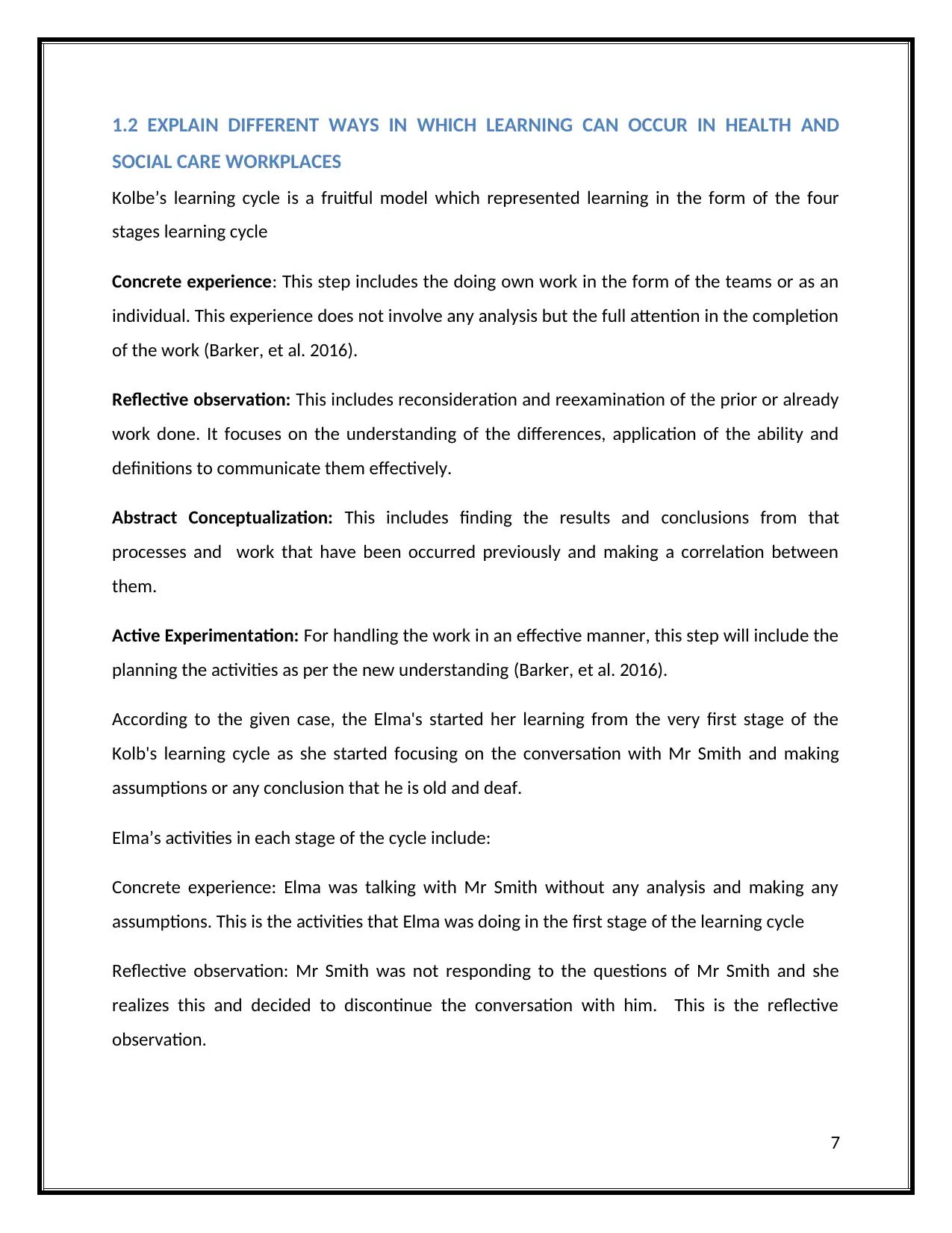
1.2 EXPLAIN DIFFERENT WAYS IN WHICH LEARNING CAN OCCUR IN HEALTH AND
SOCIAL CARE WORKPLACES
Kolbe’s learning cycle is a fruitful model which represented learning in the form of the four
stages learning cycle
Concrete experience: This step includes the doing own work in the form of the teams or as an
individual. This experience does not involve any analysis but the full attention in the completion
of the work (Barker, et al. 2016).
Reflective observation: This includes reconsideration and reexamination of the prior or already
work done. It focuses on the understanding of the differences, application of the ability and
definitions to communicate them effectively.
Abstract Conceptualization: This includes finding the results and conclusions from that
processes and work that have been occurred previously and making a correlation between
them.
Active Experimentation: For handling the work in an effective manner, this step will include the
planning the activities as per the new understanding (Barker, et al. 2016).
According to the given case, the Elma's started her learning from the very first stage of the
Kolb's learning cycle as she started focusing on the conversation with Mr Smith and making
assumptions or any conclusion that he is old and deaf.
Elma’s activities in each stage of the cycle include:
Concrete experience: Elma was talking with Mr Smith without any analysis and making any
assumptions. This is the activities that Elma was doing in the first stage of the learning cycle
Reflective observation: Mr Smith was not responding to the questions of Mr Smith and she
realizes this and decided to discontinue the conversation with him. This is the reflective
observation.
7
SOCIAL CARE WORKPLACES
Kolbe’s learning cycle is a fruitful model which represented learning in the form of the four
stages learning cycle
Concrete experience: This step includes the doing own work in the form of the teams or as an
individual. This experience does not involve any analysis but the full attention in the completion
of the work (Barker, et al. 2016).
Reflective observation: This includes reconsideration and reexamination of the prior or already
work done. It focuses on the understanding of the differences, application of the ability and
definitions to communicate them effectively.
Abstract Conceptualization: This includes finding the results and conclusions from that
processes and work that have been occurred previously and making a correlation between
them.
Active Experimentation: For handling the work in an effective manner, this step will include the
planning the activities as per the new understanding (Barker, et al. 2016).
According to the given case, the Elma's started her learning from the very first stage of the
Kolb's learning cycle as she started focusing on the conversation with Mr Smith and making
assumptions or any conclusion that he is old and deaf.
Elma’s activities in each stage of the cycle include:
Concrete experience: Elma was talking with Mr Smith without any analysis and making any
assumptions. This is the activities that Elma was doing in the first stage of the learning cycle
Reflective observation: Mr Smith was not responding to the questions of Mr Smith and she
realizes this and decided to discontinue the conversation with him. This is the reflective
observation.
7
Paraphrase This Document
Need a fresh take? Get an instant paraphrase of this document with our AI Paraphraser
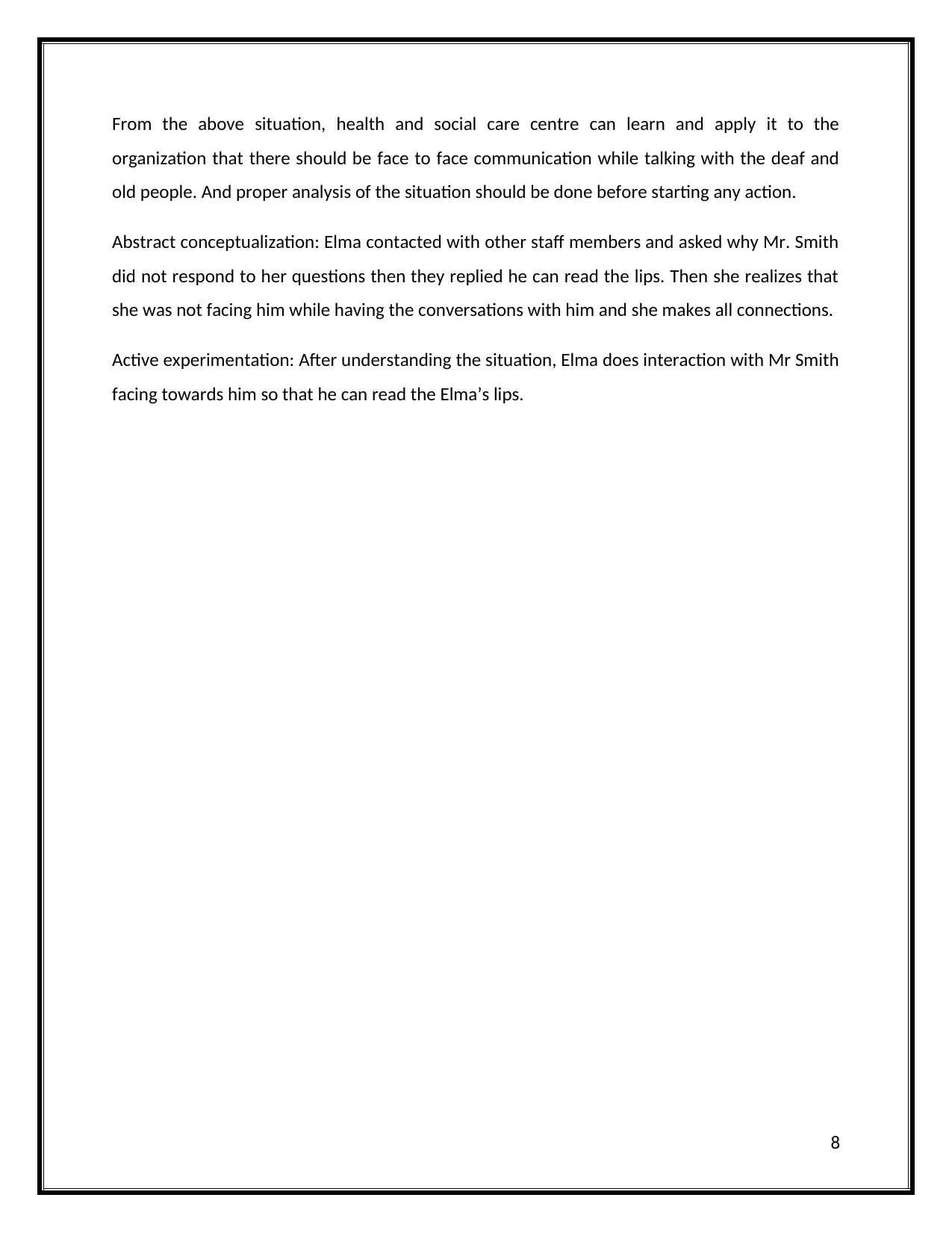
From the above situation, health and social care centre can learn and apply it to the
organization that there should be face to face communication while talking with the deaf and
old people. And proper analysis of the situation should be done before starting any action.
Abstract conceptualization: Elma contacted with other staff members and asked why Mr. Smith
did not respond to her questions then they replied he can read the lips. Then she realizes that
she was not facing him while having the conversations with him and she makes all connections.
Active experimentation: After understanding the situation, Elma does interaction with Mr Smith
facing towards him so that he can read the Elma’s lips.
8
organization that there should be face to face communication while talking with the deaf and
old people. And proper analysis of the situation should be done before starting any action.
Abstract conceptualization: Elma contacted with other staff members and asked why Mr. Smith
did not respond to her questions then they replied he can read the lips. Then she realizes that
she was not facing him while having the conversations with him and she makes all connections.
Active experimentation: After understanding the situation, Elma does interaction with Mr Smith
facing towards him so that he can read the Elma’s lips.
8
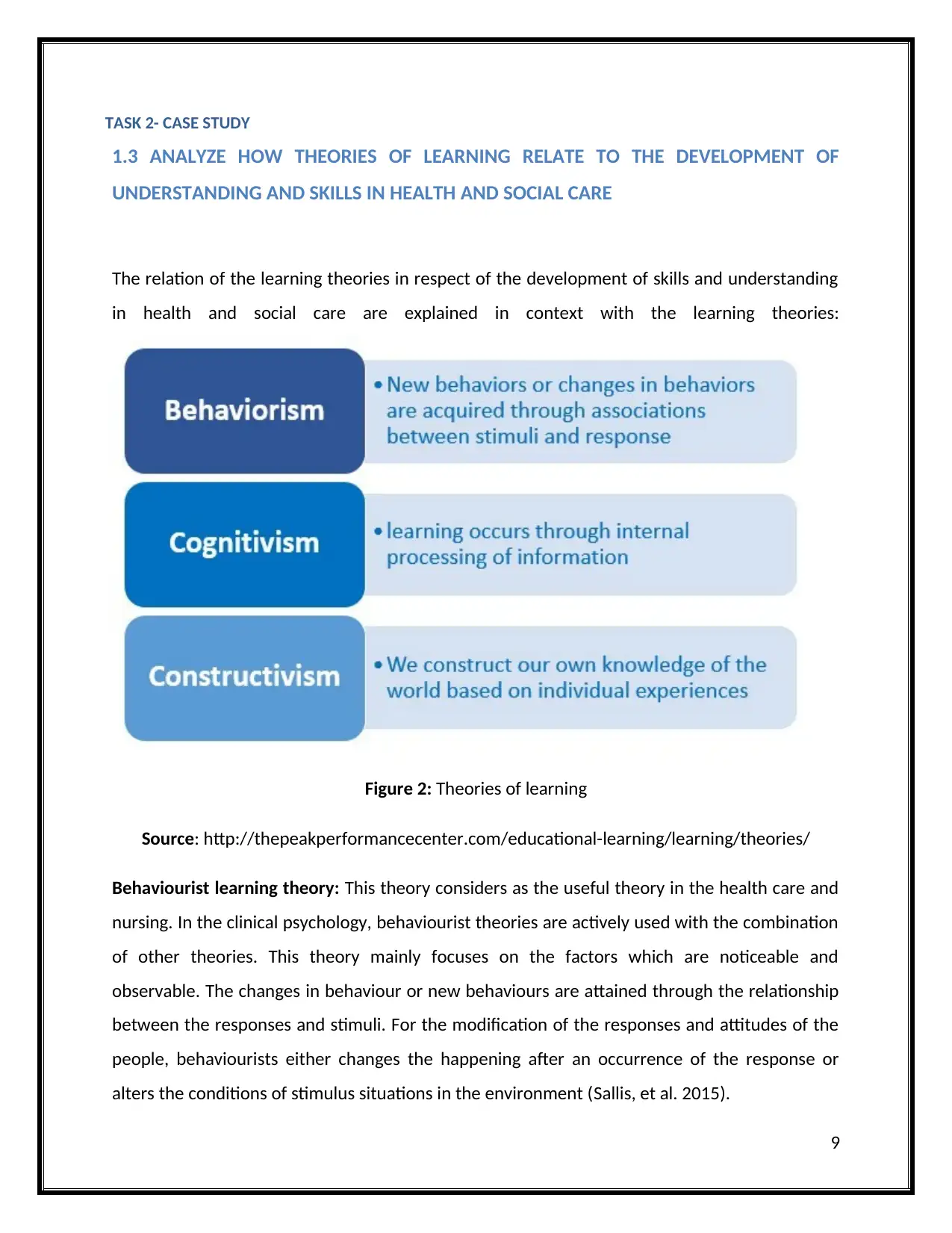
TASK 2- CASE STUDY
1.3 ANALYZE HOW THEORIES OF LEARNING RELATE TO THE DEVELOPMENT OF
UNDERSTANDING AND SKILLS IN HEALTH AND SOCIAL CARE
The relation of the learning theories in respect of the development of skills and understanding
in health and social care are explained in context with the learning theories:
Figure 2: Theories of learning
Source: http://thepeakperformancecenter.com/educational-learning/learning/theories/
Behaviourist learning theory: This theory considers as the useful theory in the health care and
nursing. In the clinical psychology, behaviourist theories are actively used with the combination
of other theories. This theory mainly focuses on the factors which are noticeable and
observable. The changes in behaviour or new behaviours are attained through the relationship
between the responses and stimuli. For the modification of the responses and attitudes of the
people, behaviourists either changes the happening after an occurrence of the response or
alters the conditions of stimulus situations in the environment (Sallis, et al. 2015).
9
1.3 ANALYZE HOW THEORIES OF LEARNING RELATE TO THE DEVELOPMENT OF
UNDERSTANDING AND SKILLS IN HEALTH AND SOCIAL CARE
The relation of the learning theories in respect of the development of skills and understanding
in health and social care are explained in context with the learning theories:
Figure 2: Theories of learning
Source: http://thepeakperformancecenter.com/educational-learning/learning/theories/
Behaviourist learning theory: This theory considers as the useful theory in the health care and
nursing. In the clinical psychology, behaviourist theories are actively used with the combination
of other theories. This theory mainly focuses on the factors which are noticeable and
observable. The changes in behaviour or new behaviours are attained through the relationship
between the responses and stimuli. For the modification of the responses and attitudes of the
people, behaviourists either changes the happening after an occurrence of the response or
alters the conditions of stimulus situations in the environment (Sallis, et al. 2015).
9
⊘ This is a preview!⊘
Do you want full access?
Subscribe today to unlock all pages.

Trusted by 1+ million students worldwide
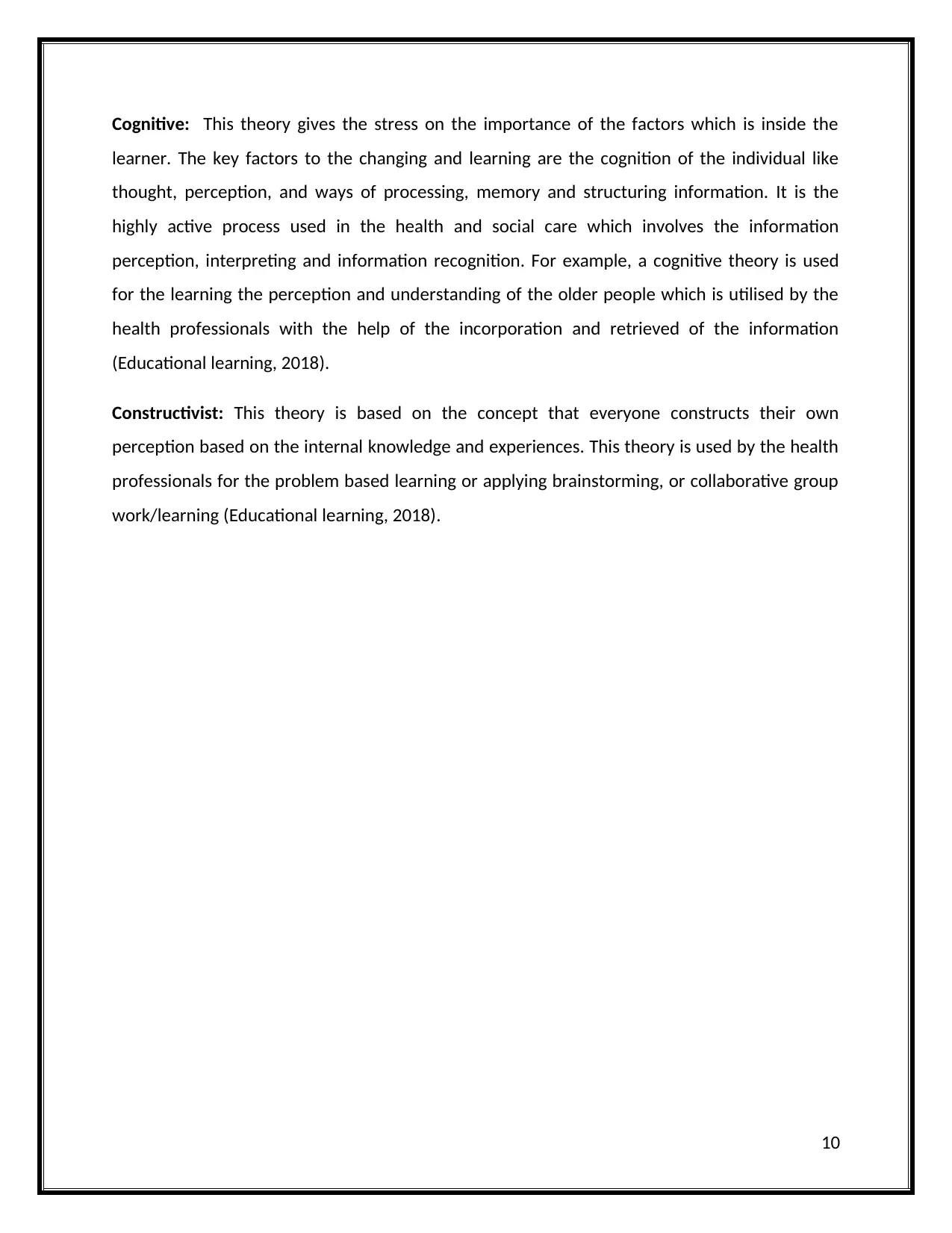
Cognitive: This theory gives the stress on the importance of the factors which is inside the
learner. The key factors to the changing and learning are the cognition of the individual like
thought, perception, and ways of processing, memory and structuring information. It is the
highly active process used in the health and social care which involves the information
perception, interpreting and information recognition. For example, a cognitive theory is used
for the learning the perception and understanding of the older people which is utilised by the
health professionals with the help of the incorporation and retrieved of the information
(Educational learning, 2018).
Constructivist: This theory is based on the concept that everyone constructs their own
perception based on the internal knowledge and experiences. This theory is used by the health
professionals for the problem based learning or applying brainstorming, or collaborative group
work/learning (Educational learning, 2018).
10
learner. The key factors to the changing and learning are the cognition of the individual like
thought, perception, and ways of processing, memory and structuring information. It is the
highly active process used in the health and social care which involves the information
perception, interpreting and information recognition. For example, a cognitive theory is used
for the learning the perception and understanding of the older people which is utilised by the
health professionals with the help of the incorporation and retrieved of the information
(Educational learning, 2018).
Constructivist: This theory is based on the concept that everyone constructs their own
perception based on the internal knowledge and experiences. This theory is used by the health
professionals for the problem based learning or applying brainstorming, or collaborative group
work/learning (Educational learning, 2018).
10
Paraphrase This Document
Need a fresh take? Get an instant paraphrase of this document with our AI Paraphraser
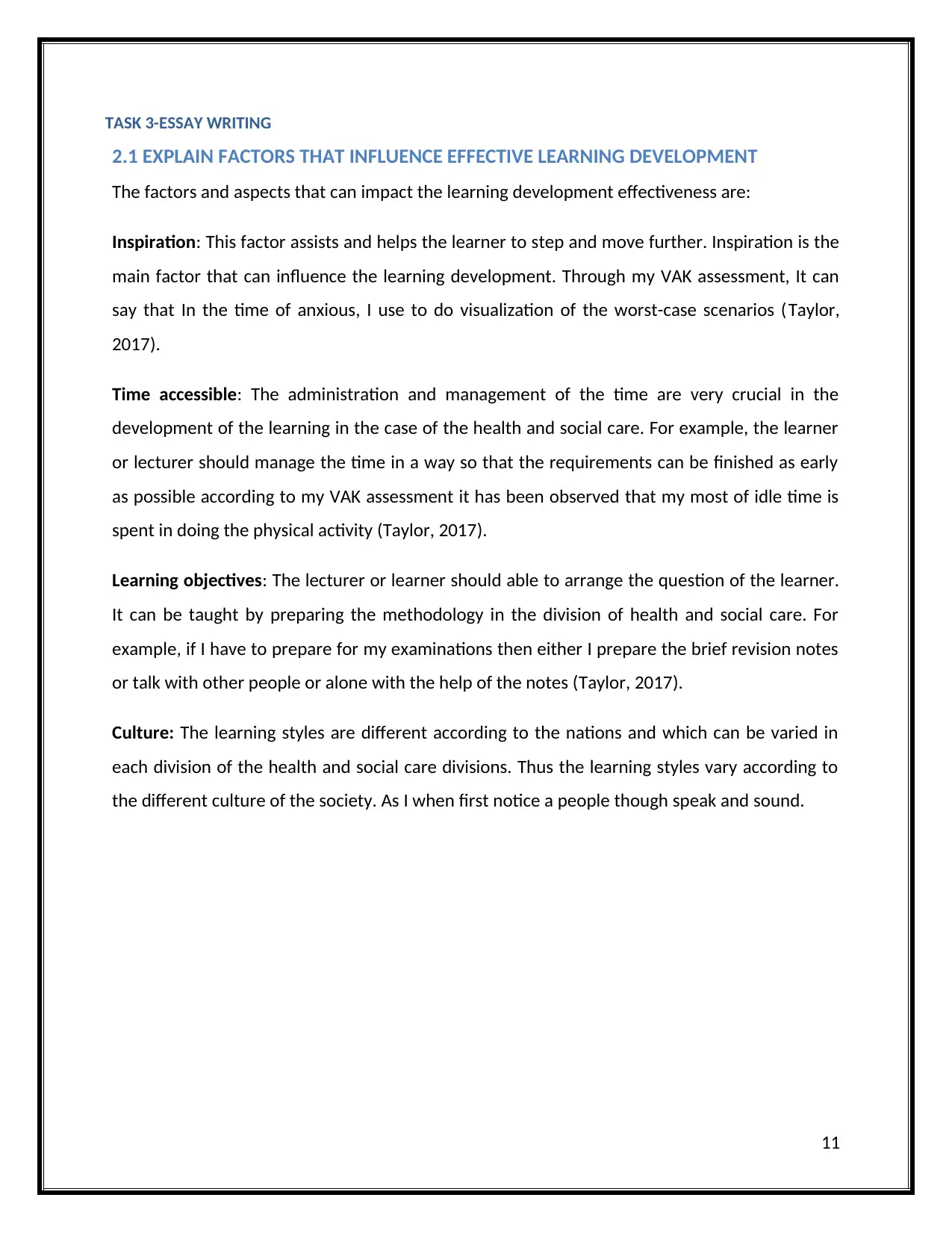
TASK 3-ESSAY WRITING
2.1 EXPLAIN FACTORS THAT INFLUENCE EFFECTIVE LEARNING DEVELOPMENT
The factors and aspects that can impact the learning development effectiveness are:
Inspiration: This factor assists and helps the learner to step and move further. Inspiration is the
main factor that can influence the learning development. Through my VAK assessment, It can
say that In the time of anxious, I use to do visualization of the worst-case scenarios (Taylor,
2017).
Time accessible: The administration and management of the time are very crucial in the
development of the learning in the case of the health and social care. For example, the learner
or lecturer should manage the time in a way so that the requirements can be finished as early
as possible according to my VAK assessment it has been observed that my most of idle time is
spent in doing the physical activity (Taylor, 2017).
Learning objectives: The lecturer or learner should able to arrange the question of the learner.
It can be taught by preparing the methodology in the division of health and social care. For
example, if I have to prepare for my examinations then either I prepare the brief revision notes
or talk with other people or alone with the help of the notes (Taylor, 2017).
Culture: The learning styles are different according to the nations and which can be varied in
each division of the health and social care divisions. Thus the learning styles vary according to
the different culture of the society. As I when first notice a people though speak and sound.
11
2.1 EXPLAIN FACTORS THAT INFLUENCE EFFECTIVE LEARNING DEVELOPMENT
The factors and aspects that can impact the learning development effectiveness are:
Inspiration: This factor assists and helps the learner to step and move further. Inspiration is the
main factor that can influence the learning development. Through my VAK assessment, It can
say that In the time of anxious, I use to do visualization of the worst-case scenarios (Taylor,
2017).
Time accessible: The administration and management of the time are very crucial in the
development of the learning in the case of the health and social care. For example, the learner
or lecturer should manage the time in a way so that the requirements can be finished as early
as possible according to my VAK assessment it has been observed that my most of idle time is
spent in doing the physical activity (Taylor, 2017).
Learning objectives: The lecturer or learner should able to arrange the question of the learner.
It can be taught by preparing the methodology in the division of health and social care. For
example, if I have to prepare for my examinations then either I prepare the brief revision notes
or talk with other people or alone with the help of the notes (Taylor, 2017).
Culture: The learning styles are different according to the nations and which can be varied in
each division of the health and social care divisions. Thus the learning styles vary according to
the different culture of the society. As I when first notice a people though speak and sound.
11
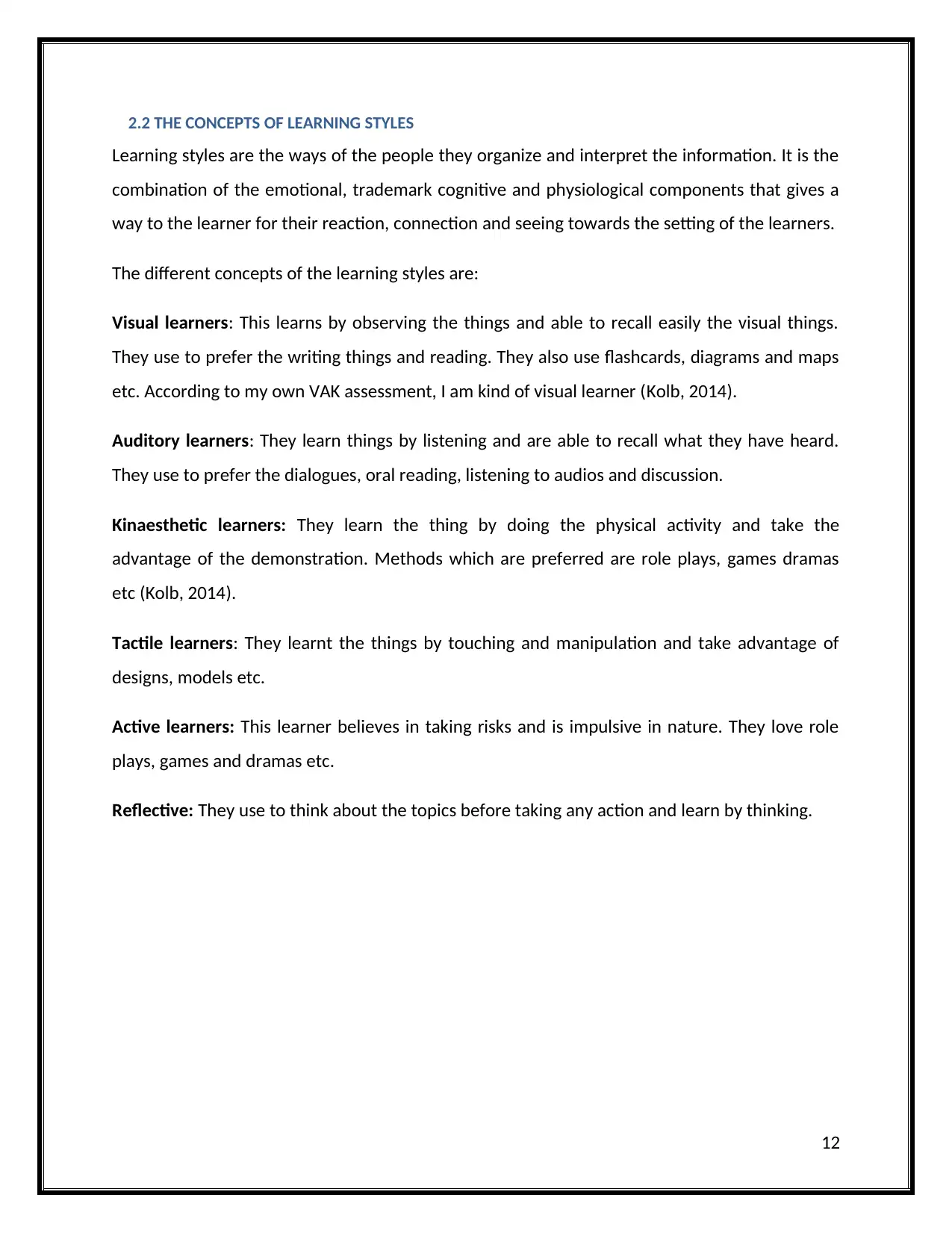
2.2 THE CONCEPTS OF LEARNING STYLES
Learning styles are the ways of the people they organize and interpret the information. It is the
combination of the emotional, trademark cognitive and physiological components that gives a
way to the learner for their reaction, connection and seeing towards the setting of the learners.
The different concepts of the learning styles are:
Visual learners: This learns by observing the things and able to recall easily the visual things.
They use to prefer the writing things and reading. They also use flashcards, diagrams and maps
etc. According to my own VAK assessment, I am kind of visual learner (Kolb, 2014).
Auditory learners: They learn things by listening and are able to recall what they have heard.
They use to prefer the dialogues, oral reading, listening to audios and discussion.
Kinaesthetic learners: They learn the thing by doing the physical activity and take the
advantage of the demonstration. Methods which are preferred are role plays, games dramas
etc (Kolb, 2014).
Tactile learners: They learnt the things by touching and manipulation and take advantage of
designs, models etc.
Active learners: This learner believes in taking risks and is impulsive in nature. They love role
plays, games and dramas etc.
Reflective: They use to think about the topics before taking any action and learn by thinking.
12
Learning styles are the ways of the people they organize and interpret the information. It is the
combination of the emotional, trademark cognitive and physiological components that gives a
way to the learner for their reaction, connection and seeing towards the setting of the learners.
The different concepts of the learning styles are:
Visual learners: This learns by observing the things and able to recall easily the visual things.
They use to prefer the writing things and reading. They also use flashcards, diagrams and maps
etc. According to my own VAK assessment, I am kind of visual learner (Kolb, 2014).
Auditory learners: They learn things by listening and are able to recall what they have heard.
They use to prefer the dialogues, oral reading, listening to audios and discussion.
Kinaesthetic learners: They learn the thing by doing the physical activity and take the
advantage of the demonstration. Methods which are preferred are role plays, games dramas
etc (Kolb, 2014).
Tactile learners: They learnt the things by touching and manipulation and take advantage of
designs, models etc.
Active learners: This learner believes in taking risks and is impulsive in nature. They love role
plays, games and dramas etc.
Reflective: They use to think about the topics before taking any action and learn by thinking.
12
⊘ This is a preview!⊘
Do you want full access?
Subscribe today to unlock all pages.

Trusted by 1+ million students worldwide
1 out of 28
Related Documents
Your All-in-One AI-Powered Toolkit for Academic Success.
+13062052269
info@desklib.com
Available 24*7 on WhatsApp / Email
![[object Object]](/_next/static/media/star-bottom.7253800d.svg)
Unlock your academic potential
Copyright © 2020–2025 A2Z Services. All Rights Reserved. Developed and managed by ZUCOL.




